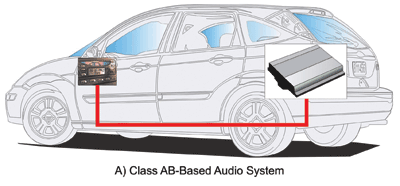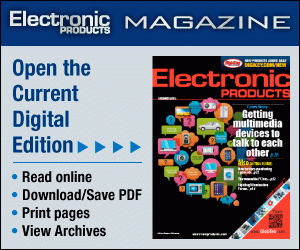Recent advances make it possible to bring high efficiency to auto applications
BY RYAN REYNOLDS
Texas Instruments
Dallas, TX
http://www.ti.com
Over the last decade, integrated Class D amplifiers have proven themselves to be extremely competitive with Class AB amplifiers for consumer applications. The power efficiency of digital amplifiers typically 90% greatly exceeds the capabilities of analog amplifiers, making them the obvious choice for a wide range of consumer audio products.
Clearly automotive applications will derive substantial benefits from digital amplifier technology, but adoption of the technology has been slow. The reason is that few, if any, digital amplifier solutions have been available that meet the stringent automotive requirements. And, those that have been available are not cost-effective. Digital amplifiers for the automotive industry must address several key design issues: exceptional electromagnetic interference (EMI) performance, high levels of integration, speaker diagnostics and a focus on automotive quality standards.
The Class D advantage
Class AB technology efficiency limitations have had a tremendous impact on the design of automotive audio systems. Many new vehicles use an external amplifier in addition to the vehicle’s primary audio head unit whenever an upgraded audio system is desired. The external or remote amplifier is used because of the poor power efficiency of Class AB amplifiers. These amplifiers generate so much heat that it is not possible to achieve the desired performance in a size and thermally limited head unit. This forces manufacturers to include an external amplifier in the vehicle for all premium sound systems and limits the base radio that can be offered.
An external amplifier enables more power with Class AB amplifiers; however, it also introduces other problems. The audio system comprises two boxes instead of one, which adds cost, wiring, and harnesses, and complicates factory installation and testing (see Fig. 1 ). Many car manufacturers also want to perform speaker diagnostics with remote amplifiers, but to do so they have to implement expensive bus architectures.


Fig 1. (a) Typical premium Class-AB-based audio system with audio head unit located up front with external amplifier located in back due to heat dissipation issues. Note the long wires connecting the two; (b) Typical Class-D-based implementation with the entire audio system located up front in the head unit.
The power efficiency of Class D amplifiers enables original equipment manufacturer (OEM) audio architects to contain the entire audio subsystem in the head unit, even for many premium systems. The number of channels and power per channel is no longer restricted to 4×20 W. Now sound quality can be improved for entry level systems and many premium systems cost less. From a cost perspective, Class AB technology is usually considered less expensive to implement per channel. The problem with comparing Class AB amplifiers with Class D amplifiers on a device basis is that such comparisons fail to take into account that Class D amplifiers enable new possibilities that are not only more fuel efficient, but also can cost less to implement.
With ever-increasing fuel efficiency requirements from governments around the world, car manufacturers are looking for ways to reduce the vehicle’s weight and power consumption. Class D offers drastic improvements for both weight and power consumption at the same time. These benefits make Class D the “greenest” audio amplifier technology available today.
Managing EMI
In a vehicle one of the major design considerations of any electrical subsystem is the electromagnetic interference (EMI) that it generates. Electromagnetic compatibility (EMC) measures how EMI is radiated or conducted to other electrical subsystems. For example, EMI can radiate off a speaker wire and couple into another electrical system. Alternatively, since all car electrical systems run from the alternator, interference from any subsystem, such as the audio amplifier, can conduct through the power wires to other subsystems.
Since EMI can adversely affect other electrical systems, including safety critical systems like airbags or antilock brakes, EMI performance is extremely important to automobile manufacturers. With millions of cars on the roads, even rare instances of interference could have dire consequences. This inherent risk is why car makers have much more stringent requirements for EMI than other applications.
Class D amplifiers by definition switch on and off at a high frequency. This switching is what gives a Class D amplifier its efficiency advantage, but also creates unwanted EMI, which has been a major stumbling block for Class D amplifiers targeting automotive applications. Therefore, initial Class D amplifiers were designed for consumer applications and adapting those to automotive EMC levels was challenging. Today a Class D amplifier for automotive applications with patent-pending technology from Texas Instruments can surpass OEM EMC requirements cost effectively.
Speaker diagnostics
Another advantage to using a head unit with Class D instead of an external amplifier is the ability to perform full diagnostics. To help reduce cost in mid-range external amplifiers, the car manufacturer does not implement a communication bus and, therefore, cannot report diagnostic information for those channels. By integrating those channels into the head unit, full diagnostics are now available for all channels without an expensive communication bus.
Designed for reliability
Given the high cost of warranty repairs and their quality image, automotive manufacturers need to ensure that every device used in a car is reliable. For these reasons, car manufacturers seek low failure rates, also referred to as defective parts per million (DPPM). Methods to achieve this goal include production burn-in, additional qualification testing and high standards for project management.
• Production burn-in reduces a phenomenon known as early life failure rate (ELFR) by stressing components. Burn-in uses temperature and voltage acceleration to emulate use in the end application to screen out weak devices that might fail early in their life.
• Additional reliability and qualification testing for automotive devices is also commonplace. Many car manufacturers have adopted a generic qualification standard known as AEC-Q100 to help standardize the requirements for semiconductor testing.
• TS16949 is another automotive industry standard [1] focused on helping to ensure high-quality project management. In part, this standard ensures the device manufacturer follows best practices, shows continuous improvement and measures customer satisfaction.
Automotive digital amplifiers such as the TAS5414A are designed specifically for automotive use. They are qualified per AEC-Q100, designed and produced in TS-16949 compliant factories and offer optional production burn-in. ■
References
[1] Technical standards for TS16949: www.ts16949.com/
To download a datasheet or for more technical information about automotive digital amplifiers, visit www.ti.com/tas5414a-ca.
Advertisement
Learn more about Texas Instruments





